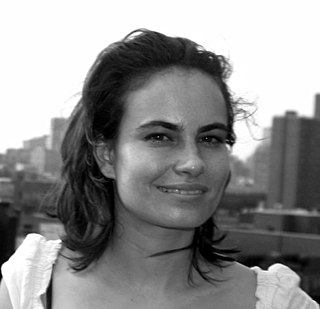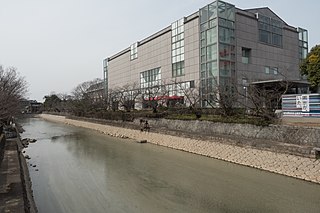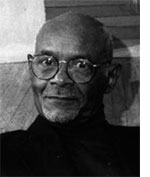
Diego María de la Concepción Juan Nepomuceno Estanislao de la Rivera y Barrientos Acosta y Rodríguez, known as Diego Rivera, was a prominent Mexican painter. His large frescoes helped establish the mural movement in Mexican and international art.

Vitreous enamel, also called porcelain enamel, is a material made by fusing powdered glass to a substrate by firing, usually between 750 and 850 °C. The powder melts, flows, and then hardens to a smooth, durable vitreous coating. The word vitreous comes from the Latin vitreus, meaning "glassy".

Cloisonné is an ancient technique for decorating metalwork objects with colored material held in place or separated by metal strips or wire, normally of gold. In recent centuries, vitreous enamel has been used, but inlays of cut gemstones, glass and other materials were also used during older periods; indeed cloisonné enamel very probably began as an easier imitation of cloisonné work using gems. The resulting objects can also be called cloisonné. The decoration is formed by first adding compartments to the metal object by soldering or affixing silver or gold as wires or thin strips placed on their edges. These remain visible in the finished piece, separating the different compartments of the enamel or inlays, which are often of several colors. Cloisonné enamel objects are worked on with enamel powder made into a paste, which then needs to be fired in a kiln. If gemstones or colored glass are used, the pieces need to be cut or ground into the shape of each cloison.

Lady Pink, born Sandra Fabara (1964), is an Ecuadorian-American graffiti and mural artist.

Inka Essenhigh is an American painter based in New York City. Throughout her career, Essenhigh has had solo exhibitions at galleries such as Deitch Projects, Mary Boone Gallery, 303 Gallery, Stefan Stux Gallery, and Jacob Lewis Gallery in New York, Kotaro Nukaga, Tomio Koyama Gallery in Tokyo, and Il Capricorno in Venice.

Luis Nishizawa Flores was a Mexican artist known for his landscape work and murals, which often show Japanese and Mexican influence. He began formal training as an artist in 1942 at the height of the Mexican muralism movement but studied other painting styles as well as Japanese art.

Jennifer Bartlett was an American artist and novelist. She was best known for paintings and prints that combine the system-based aesthetic of conceptual art with the painterly approach of Neo-Expressionism. Many of her pieces were executed on small, square, enamel-coated steel plates that are combined in grid formations to create very large works.

The National Museum of Modern Art, Kyoto is an art museum in Kyoto, Japan.

Roberto Cueva del Río, born as Rodolfo Roberto De La Cueva Del Río, was a very active Mexican muralist. He was given a number of commissions by Lázaro Cárdenas for works in Michoacan, including Pátzcuaro and Cárdenas's birthplace of Jiquilpan. He received other commissions for works in

Grete Prytz Kittelsen, was a Norwegian goldsmith, enamel artist, and designer. She is one of the most well-known Norwegians in the Scandinavian Design movement, and has been referred to as the "Queen of Scandinavian Design". Through her work she contributed to internationalisation, innovation and scientific research. She was one of the few Norwegian practitioners who shaped the Scandinavian design style in the post-war era and is the periods’ most renowned Norwegian practitioner. Kittelsen's aim was to make beautiful and user-friendly everyday objects available for everyone. She had a vast and varied production. With her enamelled objects and jewellery she has been a pioneer in design in the post-war era and a model for the next generation of designers. Today her pieces constitute design icons and are sought-after collectables.

Hughie Lee-Smith was an American artist and teacher whose surreal paintings often featured distant figures under vast skies, and desolate urban settings.

Various types of visual arts developed in the geographical area now known as Mexico. The development of these arts roughly follows the history of Mexico, divided into the prehispanic Mesoamerican era, the colonial period, with the period after Mexican War of Independence, the development Mexican national identity through art in the nineteenth century, and the florescence of modern Mexican art after the Mexican Revolution (1910-1920).
Gustavo Arias Murueta was a Mexican painter, sculptor and poet, a member of the Salón de la Plástica Mexicana best known for his work in drawing, graphic arts and oil painting. He originally studied architecture at the Universidad Nacional Autónoma de México where he met artists such as Rufino Tamayo, David Alfaro Siqueiros and José Clemente Orozco. In the 1950s, he began to produce artworks, with his first exhibition in 1961. From then until his death he had a career as an artist with individual and collective exhibitions in both Mexico and abroad. While his work had been heavily influenced by Orozco, he was considered part of the Generación de la Ruptura movement.
Sofía Bassi was a Mexican painter and writer noted for her surrealist work as well as her personal life, which included five years in prison for murder. She maintained an active career despite incarceration, painting her first mural in prison in Acapulco, with the assistance of Alberto Gironella, José Luis Cuevas, Rafael Coronel and Francisco Corzas. This mural can now be found at the municipal building of the city.
José Reyes Meza was a Mexican painter, costume and set designer, who helped to found a number of cultural institutions in Mexico. Reyes Meza began his artistic career principally in theater, although he was an active painter and even bullfighter in his early days. Painting became prominent starting in the 1970s, working on murals in various parts of Mexico as well as exhibiting canvas works in Mexico and abroad. The artist is a founding member of the Salón de la Plástica Mexicana and his work has been acknowledged by tributes, various awards and an art museum in Nuevo Laredo named after him.
Myriam de la Riva is a Mexican artist known for her small scale works as well as portable murals. She was born in Mexico City to a European family in exile. She studied art in both Mexico and the United States as well as with a number of notable Mexican artists. The artist has had over fifty individual exhibitions and her work has been shown in over 500 collective shows. Her work has been recognized with membership in the Salón de la Plástica Mexicana, among other awards.

Ethel Spears (1903–1974) was an American artist known for her humorous paintings of Depression-era urban life.

Martha Nessler Hayden is an American artist, known for Modernist landscape painting and artist books. Hayden lives and works in Sharon, Wisconsin, in a historic Victorian home.
Carol Bennett is a Hawaii based painter and glass artist.
Boris Deutsch (1892–1978) was a naturalized American painter.













